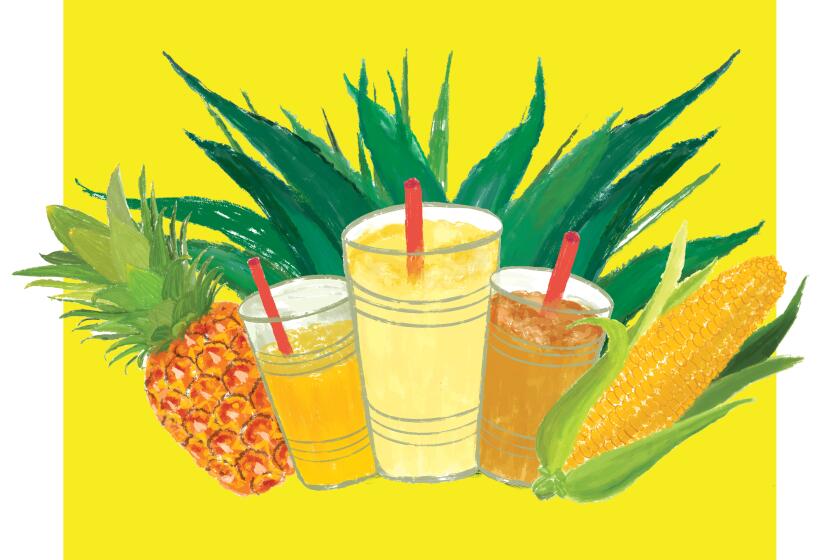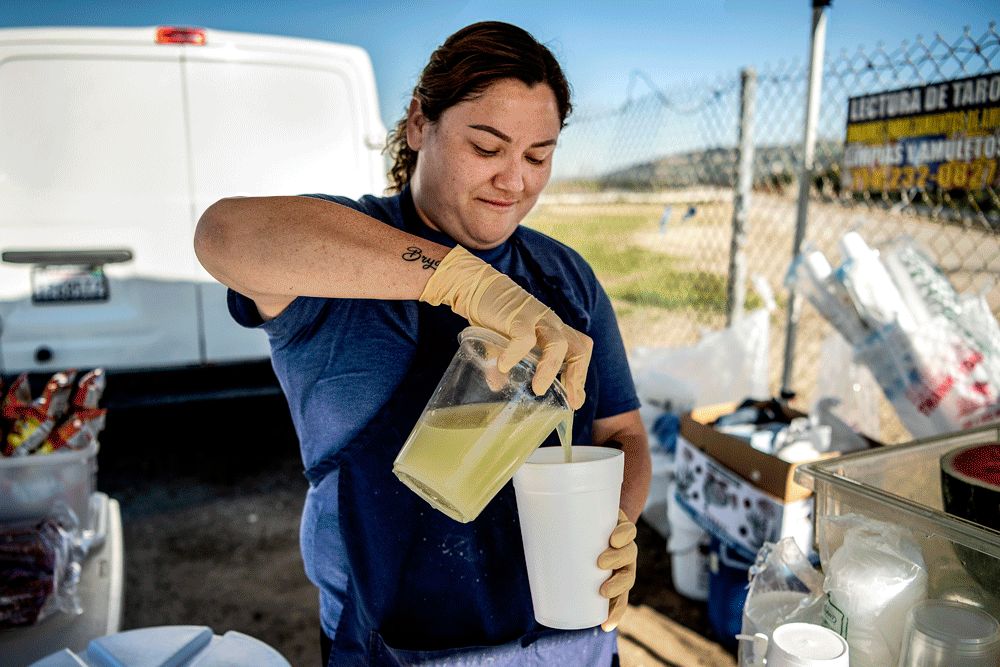
Tepache, tejuino and pulque are rustic beverages with Indigenous roots, yet they’re still barely known north of the border.

Evelyn Flores, a roadside vendor in the Whittier Narrows, sparks up with mischief as she prepares the drink that her family has been selling from the same spot for decades: tejuino, a rustic beverage from Mexico.
First, she grabs a large foam cup and rams it with ice; then she squeezes the juice from several limes into the cup and adds a spoonful of salt. Next, Flores pops open a barrel-sized container filled with a slushy brown liquid. She dunks a mug inside to stir it around, fills the mug and then transfers the fluid into the foam cup and back again, mug and cup, cup and mug, swishing and sloshing.
Already, from a few feet away, the funky smell of the drink reaches me.
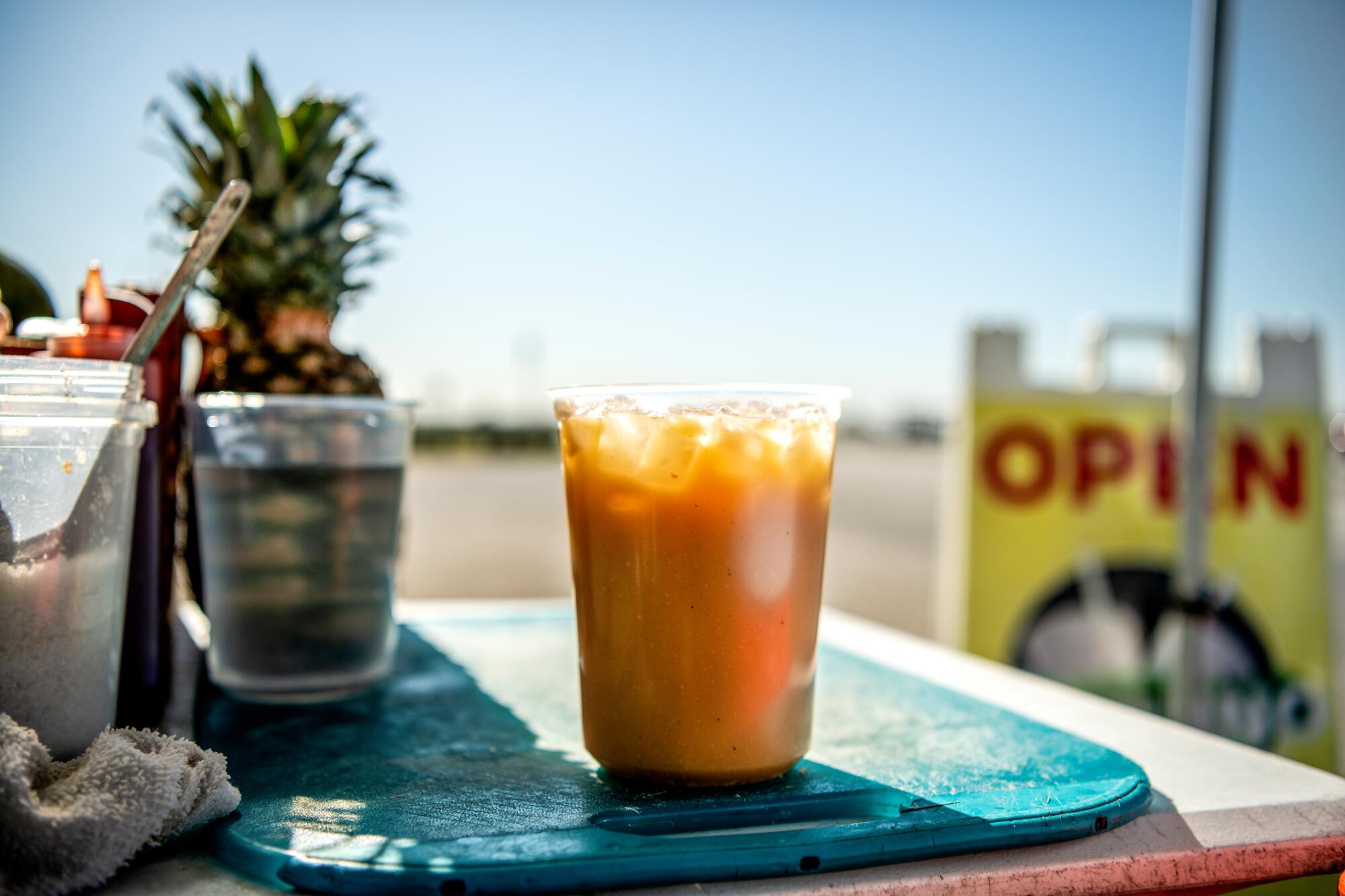
Tejuino, from the western region of Mexico, is a fermentation of maíz with piloncillo, or Mexican brown sugar. After a few days in water, the yeasts involved turn the mixture into a brown, almost milky mush. In the city of Guadalajara and at roadside stands in the states of Jalisco, Nayarit and Colima, tejuino is served with big chunks of ice, lime juice and sea salt. Sometimes vendors drop in a scoop of lime sorbet, which bleeds into the liquid with wisps of neon green.
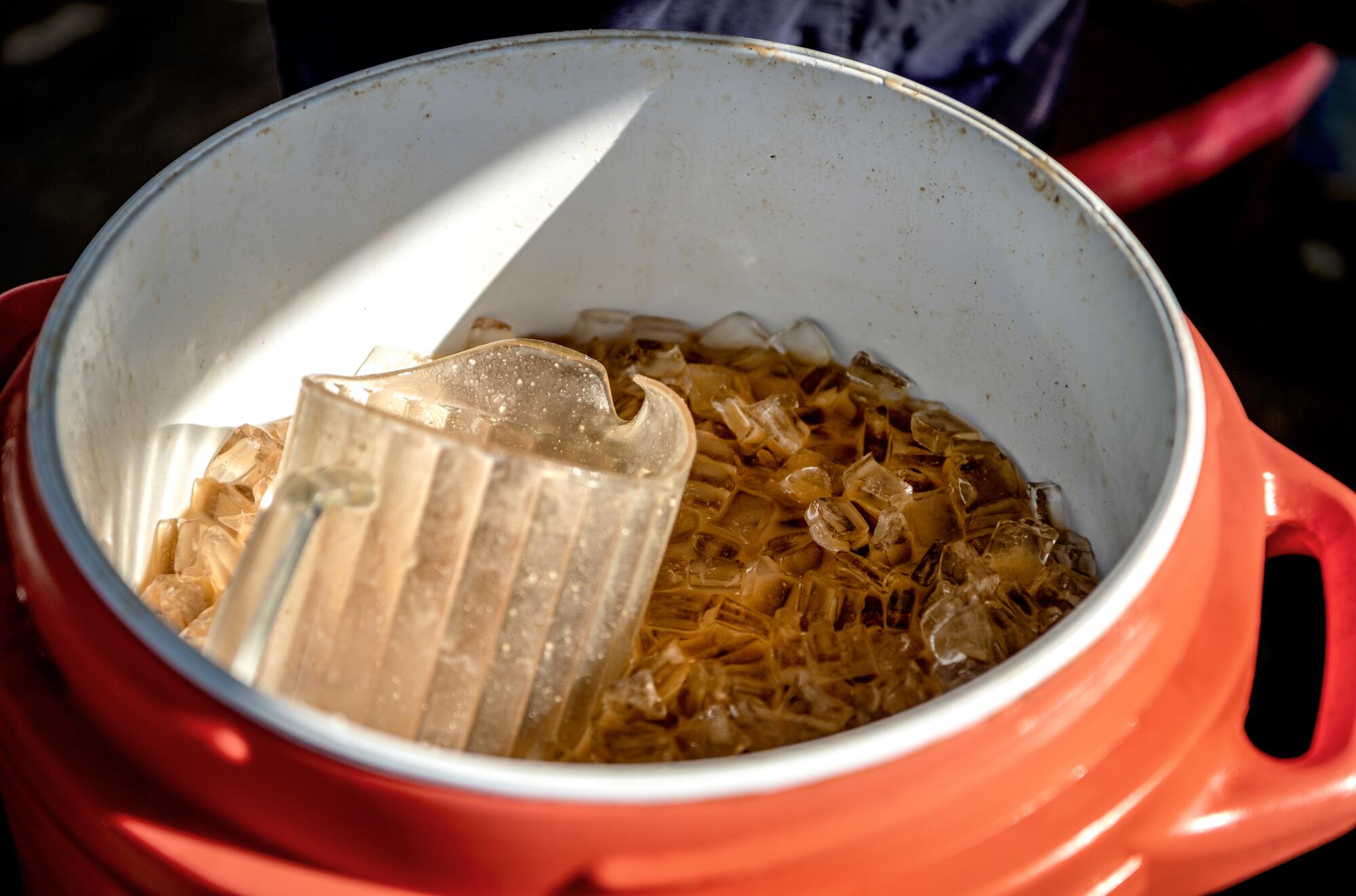
I take a sip. It is sour but refreshing, slightly fizzy in texture.
‚ÄúIt‚Äôs good, right?‚ÄĚ asks Flores, 28, in an upward-sounding Eastside accent.
‚ÄúIt‚Äôs so good,‚ÄĚ I say reflexively.
Most people outside Mexico are familiar with the country’s tradition of distillates and beers. Far fewer have experienced an entire other galaxy of beverages, like tejuino, that are much less available here in Southern California. They are made with Indigenous-based practices, typically inside people’s homes, usually with a plant, like corn, that’s already used for a bunch of other things in Mexico.
Besides tejuino, these drinks include tepache, made with fermented pineapple rinds and spices, and pulque, a most esoteric liquid, which is fermented agave sap that pours like a foggy syrup. Mexicans have enjoyed such drinks with little notice for centuries and largely avoided embracing them in packaged or processed form.
Researchers have identified 16 traditional fermented beverages in Mexico, according to a 2021 academic paper in the journal Foods, which describes them as a ‚Äúbiocultural unseen foodscape.‚ÄĚ
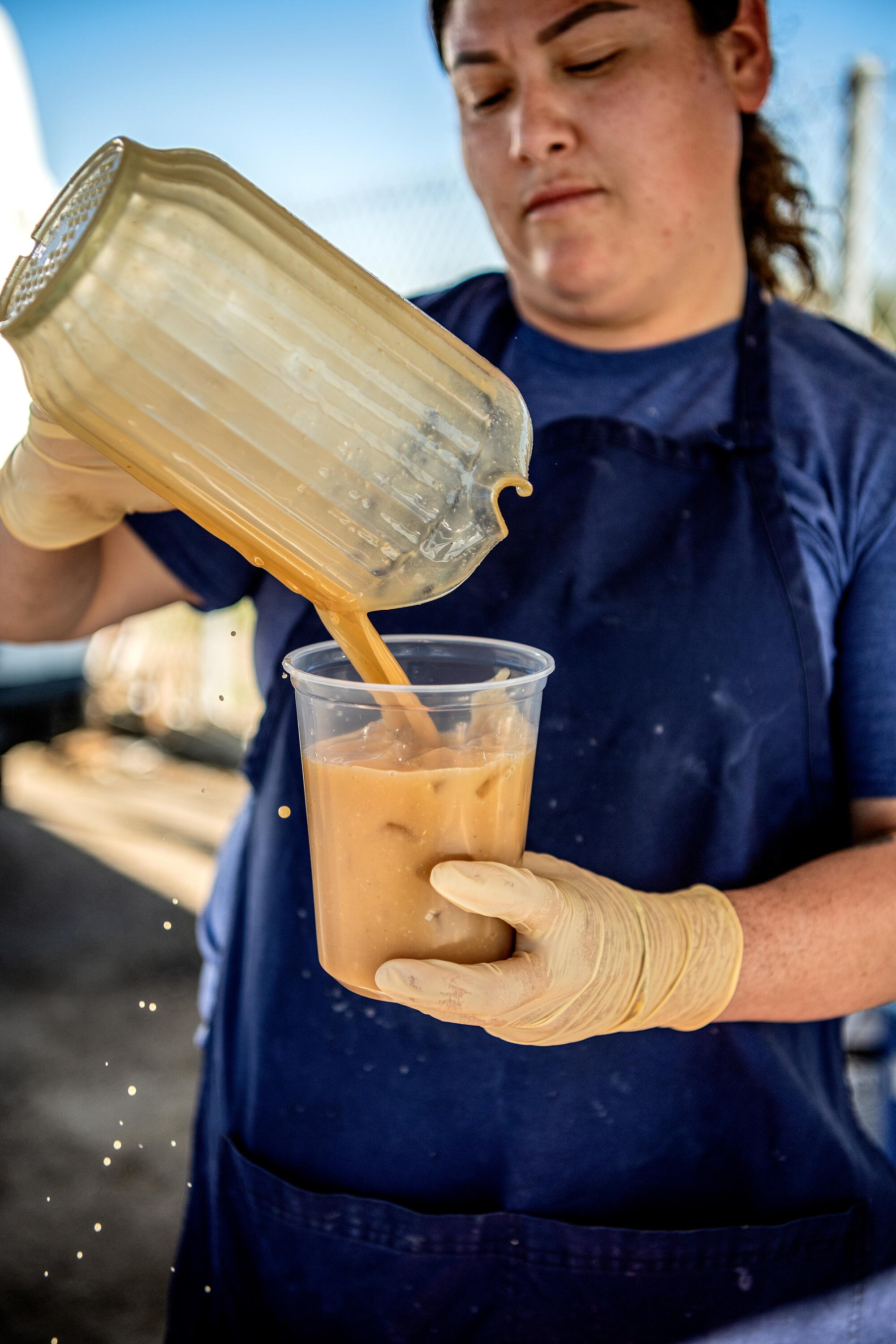
I learned to love these drinks while living in Mexico, and, eager to find them replicated in L.A., I decided some research was in order. For weeks, I‚Äôve tracked street vendors, stores and restaurants in L.A. County that sell these particular three ‚ÄĒ tejuino, tepache and pulque ‚ÄĒ with great expectations, and only moderate successes.
The Flores family stand on Rosemead Boulevard is getting it right.
As I drink their tejuino, I turn to Bryant Orozco, a Long Beach-born specialist in Mexican alcoholic beverages who has worked at the bars of L.A. restaurants Madre and Mírame. Lately, he’s become as invested in exploring Mexican ferments as I have.
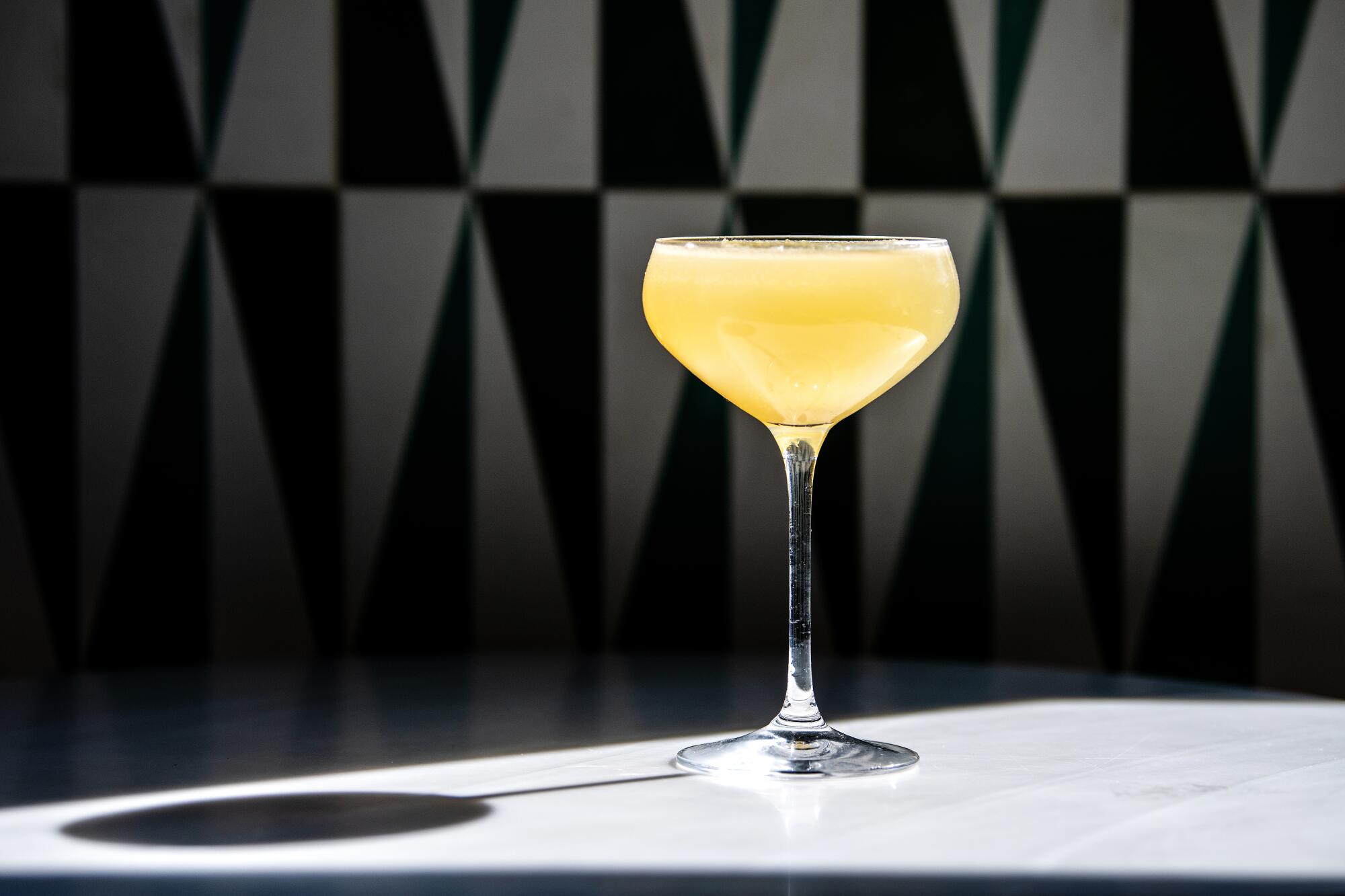
‚ÄúYou get this masa, this mash, and you ferment that mash with natural yeast,‚ÄĚ Orozco explains as we slurp in our roadside tejuino. ‚ÄúIt‚Äôs not beer, where you inoculate it with yeast. It‚Äôs just the ambient yeast, whatever you have in your olla [pot], wherever you‚Äôre fermenting.‚ÄĚ
During the early pandemic lockdowns, he started making his own tejuino at home, intent on replicating the flavors of the drink as he’d have it while visiting his ancestral lands of Sonora, Zacatecas and Nayarit. After a while, it worked.
‚ÄúI wanted to see if I could make it,‚ÄĚ Orozco says. ‚ÄúThe yeasts and bacterias are eating the sugars. You get the gas, the carbon dioxide, a little bit of alcohol, not enough to get drunk, but it also depends a lot on the ambient temperature.‚ÄĚ
The roar of the vehicles blasting past us whips our hair and loose clothing. Rosemead Boulevard, just south of the 60 Freeway and running through the Whittier Narrows, is a fast-moving stretch with gravelly shoulders. It feels like it may as well be a highway in Nayarit. We laugh as we spot two men on horseback at the nearby Chevron station.
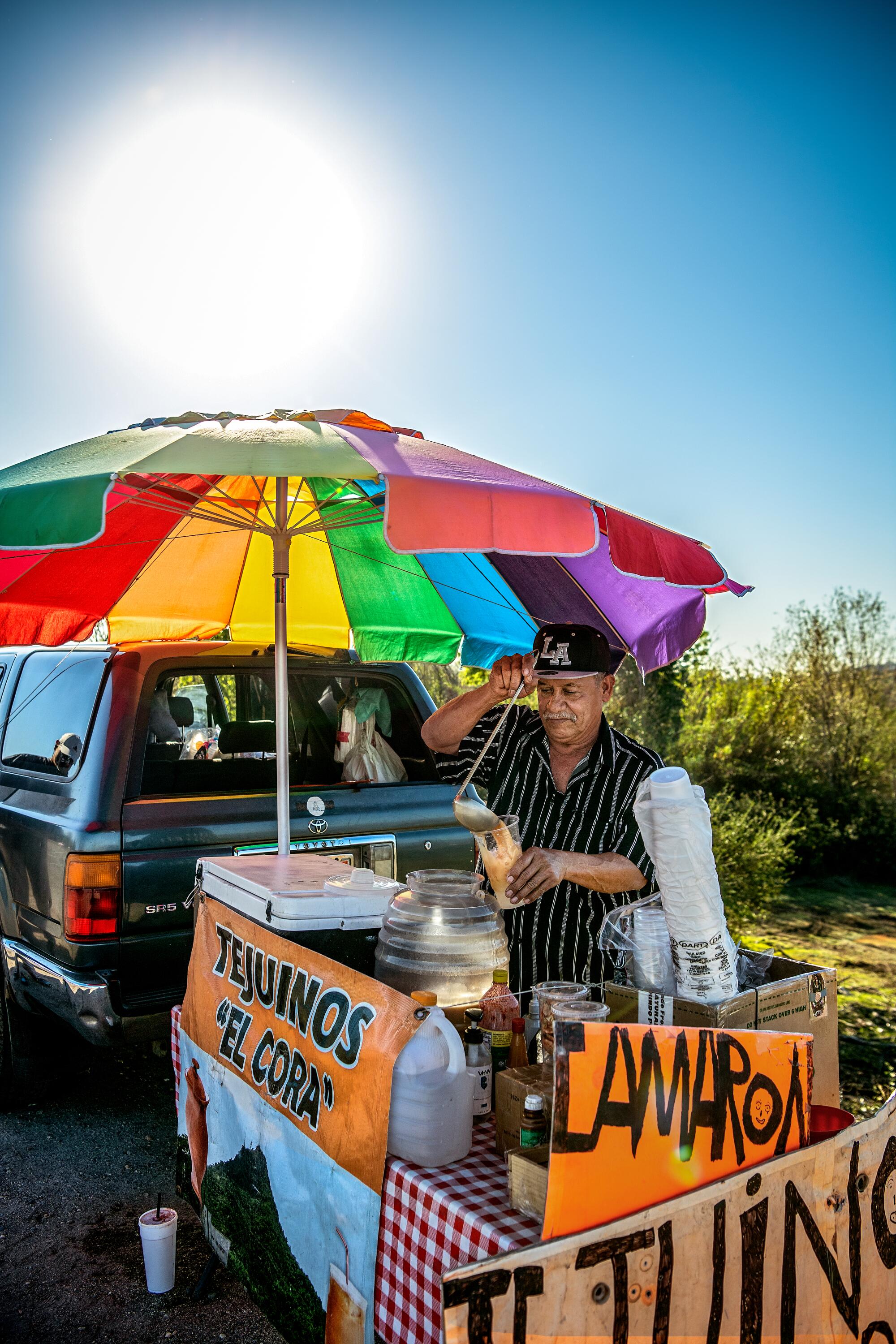
A few other vendors are selling tejuino on the other side of the road, making this area a veritable corridor of the drink. I take another sip and feel transported, remembering the time I first tried tejuino, from a vendor at the cavernous San Juan de Dios market in downtown Guadalajara, Mexico’s second-largest city. The drink bites the tongue.
Flores tells us she was born and raised in Boyle Heights. Her parents are from Guadalajara. It took her years of study to become a hospital technician, her day job. She works at the stand off and on to help her family.
‚ÄúI was 8 years old when my mom used to bring me here,‚ÄĚ Flores says. ‚ÄúShe needed help, and my brothers were too embarrassed to be at a stand.‚ÄĚ
Pulque, tejuino, tepache: how to tell you’re drinking the good stuff.
The Flores family has been selling tejuino from this spot, she says, for nearly 30 years. Now they have a brick-and-mortar location next to a laundromat just down the road. They keep the roadside stand, seemingly, for its sentimental value.
‚ÄúWho is your clientele?‚ÄĚ I ask.
‚ÄúLike them,‚ÄĚ Flores says, pointing to an older couple who have just pulled up in a dusty pickup truck.
The driver, Reyes Leal, seems like the kind of gentleman whose entire life has been spent tending to greenery and eating unprocessed, homemade Mexican food. The old man beams.

‚ÄúThe tejuino here is just delicious. This is how they prepare it in Ciudad Guzm√°n,‚ÄĚ he says, mentioning his hometown in Jalisco.
His passenger is his wife, Maria Leal, who is also smiling broadly. ‚ÄúIt‚Äôs just so flavorful,‚ÄĚ she offers before the pair peel off, back into the swoosh of traffic.
‚ÄúThey come here like almost every day,‚ÄĚ Flores says proudly.
Mezcal has a huge market now. Tacos are everywhere. Guacamole rules. In our era of hyperglobalization, where everything is over-processed and looped back to us as perpetual consumers, it is a marvel that an experience like that of drinking tejuino has eluded mass awareness or commercialization, even as almost 4 million people in L.A. County trace their roots to Mexico.
This raises a crucial question: Are these artisanal fermented drinks a sort of ‚Äúfinal frontier‚ÄĚ in the importation of Mexican culinary practices to the United States?

I am unusually enamored with fermented drinks.
I reach for ginger beers or root beers whenever I spot them at L.A. delis or liquor stores. I was an instant fan of makgeolli, or Korean rice wine, the first time I tried it during a rollicking dinner at a Koreatown barbecue spot. For me, the more acidic, foggy or generally challenging, the better the beverage.
I happily indulge in this obsession whenever I am in Mexico, where enjoying foods that are unprocessed or unrefined is treated like an unmentioned birthright. In Mexico City, I got to know tepache by hanging out at the tianguis, or street markets ‚ÄĒ maybe a little too much. Any day of the week, I could throw a dart on a map of the city and land on a transient network of street stalls, a labyrinth filled with wonders, from pirated movies to brand-new Nikes of uncertain provenance.
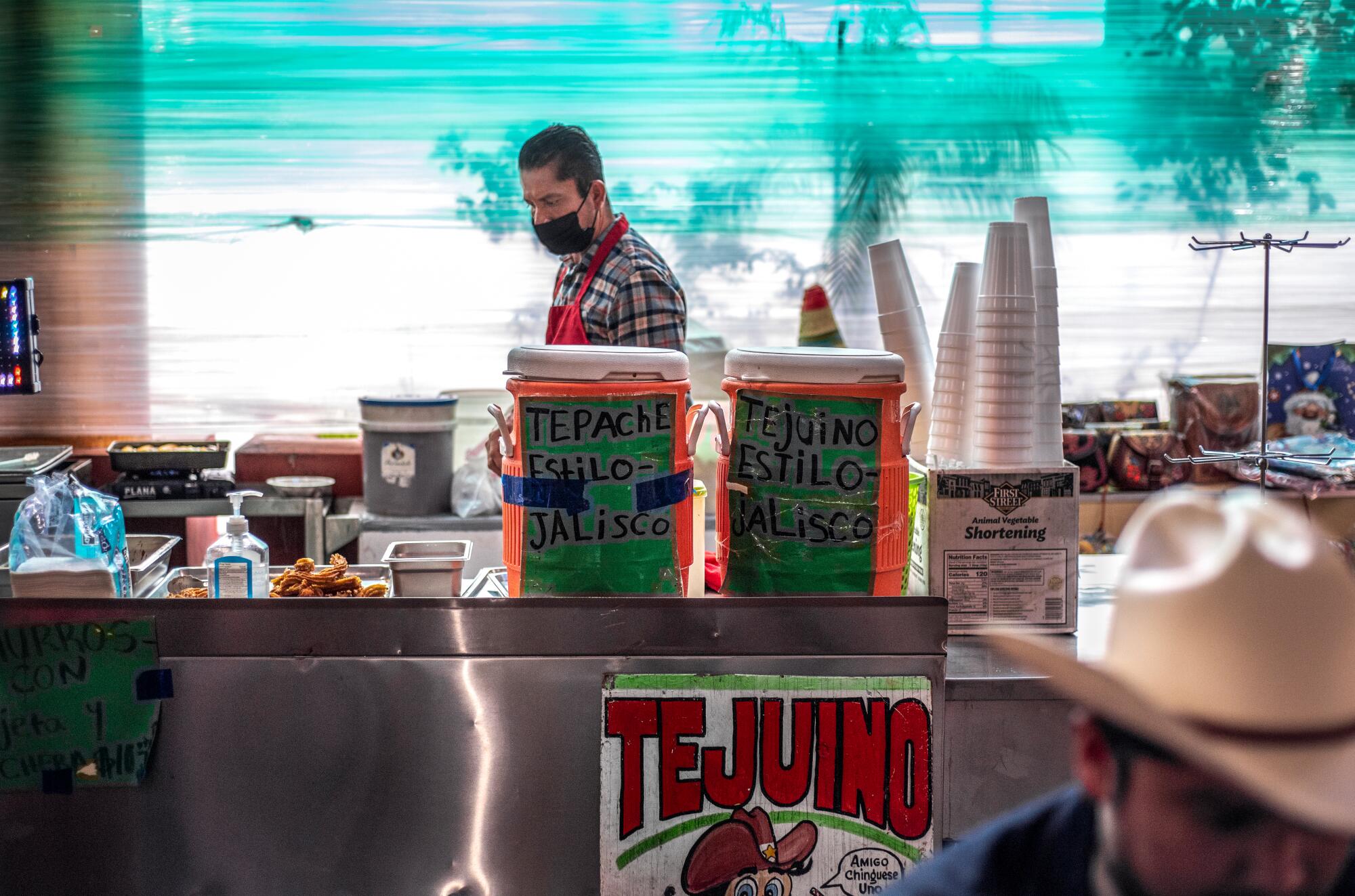
These markets also draw food and alcohol vendors. Wheeled carts might be spotted, with vendors who are hawking tepache made with pineapple rinds and spices. It usually is a dark brown liquid, presented in a clear plastic bag with a straw tied on with a rubber band. Ethanol content is negligible, if present at all. Sold icy-cold from a cooler, it is a perfect salve to counter the hotness of sun and bodies of a high-altitude street market. In L.A., I find it is most abundant during warm weather in and around the Alameda Swap Meet.
This drink is also the closest of the fermentations of Mexico to approach potential ‚Äúbreakthrough‚ÄĚ status in the United States. Many companies are currently canning it and referring to it as ‚Äúlike a kombucha‚ÄĚ due to its lightness and effervescence. Products are increasingly appearing in health-food stores, part of a bubbling movement among some academics and entrepreneurs who argue that ferments from Mexico should be more aggressively catalogued, preserved and consumed.
Rafael Martin del Campo is banking on the relative approachability of tepache. He is co-founder, along with Alex Matthews, of De La Calle, an L.A.-based company that is taking strides toward making tepache a certifiable trend.

The company‚Äôs online imprint is slick and sophisticated. Its 12-ounce cans of nonalcoholic tepache flavors are designed with a color palette that somehow screams ‚ÄúMexico‚ÄĚ: electric pinks, blues and greens. New flavor varieties are intriguing, including chamoy, cactus prickly pear and watermelon jalape√Īo.
‚ÄúI think people are accepting it and learning more about the culture and the history of this beverage,‚ÄĚ Martin del Campo says. ‚ÄúI developed this as a family recipe.‚ÄĚ
He grew up watching his grandmother make the drink at home in Querétaro, Mexico. Martin del Campo went on to study fermentation in a food sciences and technology program in college.
We try several of the new flavors, and each one is agreeable and distinct, with no artificial aftertaste.
‚ÄúWe want to use ingredients that are very traditional for our culture in Mexico and source as much as possible from Mexico,‚ÄĚ Martin del Campo explains.
He says his products are easy to mix with mezcal or tequila. And that’s exactly what some folks are doing, he notes. The drinks are also great as is; the colas of the world should be worried.
‚ÄúI would love to sell this product everywhere,‚ÄĚ Martin del Campo adds.
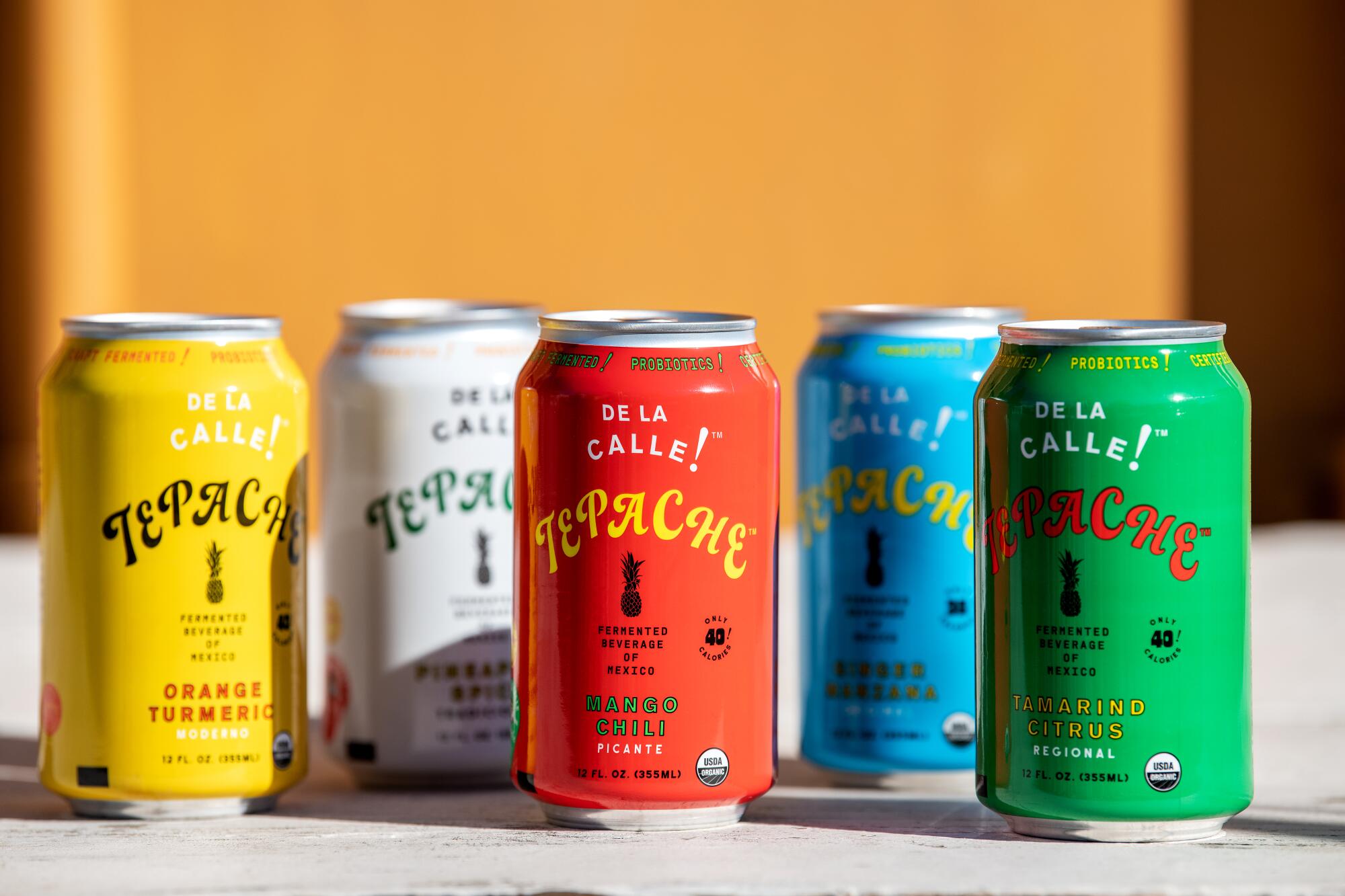
A few days later, I meet Orozco again to share some samples of the De La Calle flavored tepaches. Orozco admits he has orthodox standards when it comes to tastings of fermented drinks.
We crack open several cans, and he eyes them distrustfully. ‚ÄúThey definitely have a certain clientele they‚Äôre trying to talk to, more of that ‚Äėchipster‚Äô crowd, a more American crowd maybe,‚ÄĚ he says, using a slang term for Chicano hipsters.
Orozco drinks, frowns, suppresses a smile. ‚ÄúIt‚Äôs refreshing, it‚Äôs tart. It drinks like a tart cider. I would not characterize this as tepache, but it‚Äôs tasty.‚ÄĚ
I respect his assessment, but I don’t not like what De La Calle is making. I am impressed that someone has even attempted to do this, I say to my cohort, because he and I both know that the bar is so high.
When it comes to Mexican fermented beverages, at least one of them is like a holy grail: pulque.

I’ve been searching for good pulque in L.A. for years.
After falling under its spell down south, I returned to the United States just in time to watch the country devolve into a cauldron of political loathing. I‚Äôve more or less spent the intervening time looking for my preferred form of relief ‚ÄĒ having a culinary experience, even for a moment or two, that might remind me of a place other than here.
Pulque is not for everyone: It‚Äôs most similar to makgeolli ‚ÄĒ viscous, with a yeasty flavor in its basic form. It‚Äôs said to contain millions of microorganisms and bacteria per milliliter that happily find a home in your gut‚Äôs microbiome.

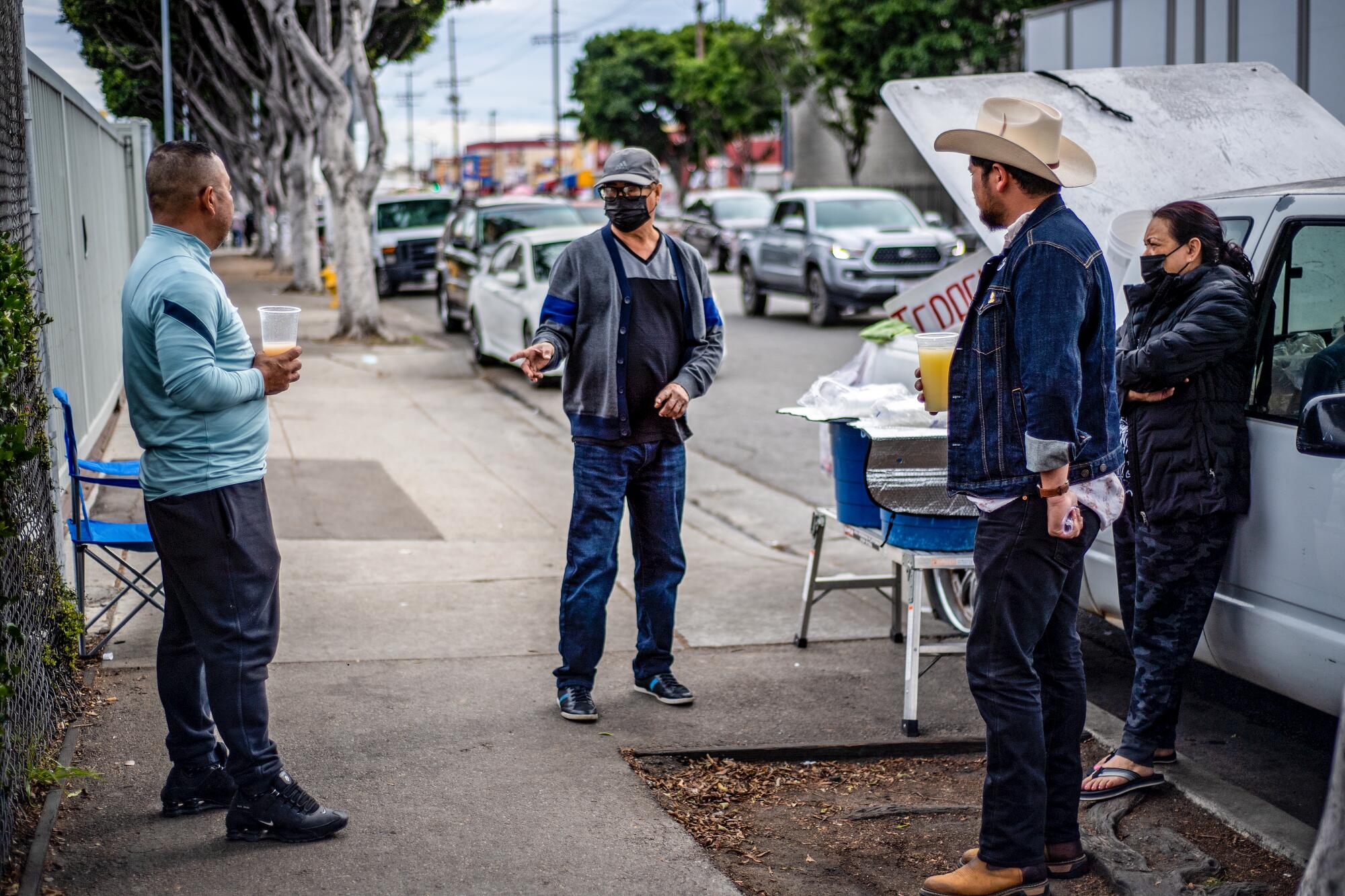
The drinking of it is immensely appealing as a social ritual. Something happens in the air after a few minutes around people who are drinking it together. It is a gentle upswing of friendly ‚ÄĒ or ‚Äúfriendly‚ÄĚ ‚ÄĒ banter, joking and flirting.
On a recent Saturday morning, I am hovering near a street vendor on a corner of Olympic Boulevard in downtown L.A., with Orozco again. He tells me that once someone tries pulque from a primary source, directly at a highland ranch somewhere on the outskirts of a big city in Mexico, crafted by an artisan who ‚Äúscrapes‚ÄĚ it, there‚Äôs no going back. We may search for a similar experience here, but it is almost always a tragic enterprise. After about two days, even a perfect fermentation of pulque starts to rapidly degrade.
The drink is as old as civilization in Mesoamerica. The ‚ÄúMural of the Drinkers,‚ÄĚ a brilliant red-hued painting dated to A.D. 200 that was uncovered in the city of Cholula, Puebla, shows 164 figures seemingly in a state of rapture as they drink pulque. The fermentation of aguamiel sap ‚ÄĒ from the core of the agave ‚ÄĒ is likely thousands of years older, researchers say.
Its use was largely reserved for priests during religious ceremonies in pre-Columbian times. After contact with Europe, the rulers of the Spanish colony attempted to stamp out its consumption ‚ÄĒ and almost succeeded. Yet pulque has remained remarkably resilient; our vendor is selling a variety of pulque flavors, or ‚Äúcurados,‚ÄĚ from the back of a pickup truck.
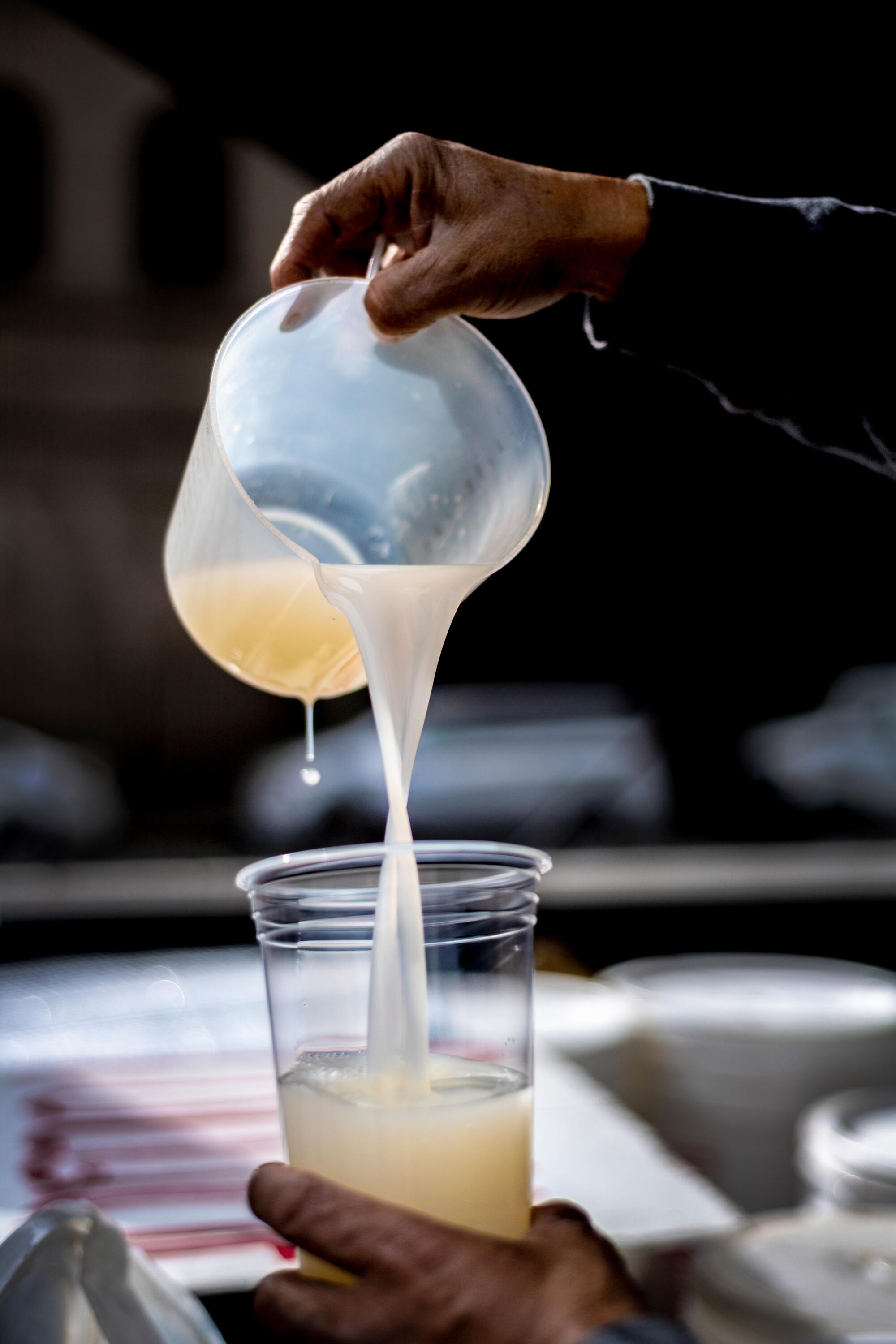
At first, he tells me his name is ‚ÄúCarlos‚ÄĚ Reyes. But on a secondary visit, he admits that his name is actually Jose Reyes, and he is compelled to offer to show me his Facebook profile to prove it. For a street vendor like him, Reyes later explains, there is no safe place on the streets of L.A. Despite being technically ‚Äúdecriminalized‚ÄĚ and despite years of being allowed to operate ‚ÄĒ discreetly, de facto ‚ÄĒ he and other street vendors still have no safety net, no way to protect or insure their businesses.
A few customers pull up to Reyes and order full gallons to-go. Others linger a bit as the vendor pours. Two women ‚ÄĒ absolute strangers ‚ÄĒ are engaged in a hearty exchange of ribbing as fans of competing Mexican professional soccer teams.
Some days, Reyes’ pulque is quite good, almost there. Other days, it is too vinegary, or simply flat.

I tell him all this, and he explains that the quality pretty much comes down to the pulque that is delivered to him. Reyes declines to divulge the identities of his suppliers, yet he is unabashed in asserting his pulque is the best in L.A. ‚ÄúKombucha has nothing on this,‚ÄĚ he boasts.
There is no verified production of this drink in Los Angeles. A few street vendors will make reference to a mythical source in ‚ÄúVictorville‚ÄĚ but give contradictory indications as to whether any pulque is actually being made there or is imported from Mexico by someone in Victorville. Vendors in L.A. ‚ÄĒ the few who exist ‚ÄĒ will merely say that they acquire the drink from someone who brings it up from Mexico, in a kind of unofficial foodways line that secretly exists among many immigrant cultures that thrive in Southern California.
A driver named Marlene Chapa pulls over. She leaves her adult son in the car, pops out and approaches the stand. She asks Reyes for a liter of the ‚Äúblanco,‚ÄĚ or plain pulque.
‚ÄúI come here a lot,‚ÄĚ she tells me. ‚ÄúI use it to make pan de pulque.‚ÄĚ
As in, pulque bread? Of course, I think. Pulque would supply a baker with an abundance of yeasts to leaven bread. Chapa is 56, lives in Lynwood, and is a native of the state of Hidalgo, Mexico. She says she’s spotted canned pulques in corner stores, and she’s been disappointed.

‚ÄúI tried one once and tossed it,‚ÄĚ she says. ‚ÄúThree years ago, I drove past and saw [Reyes] and went, ‚ÄėPulque?‚Äô So I come here to get it. I also get the curados, especially the guayaba.‚ÄĚ
In the past two decades or so, pulque has become embraced by younger generations in Mexico, part of efforts to reclaim aspects of pre-Hispanic culture that were looked down upon for centuries. So if pulque is intoxicating, fun to drink and native to this continent, and if L.A. is ‚Äúso Mexican,‚ÄĚ why isn‚Äôt anyone here making it commercially yet?
Reyes seems perplexed by the question. The artisan term for a person who draws aguamiel from an agave plant is ‚Äútlachiquero.‚ÄĚ Maybe, Reyes offers, an exemplary tlachiquero hasn‚Äôt migrated north yet. Or maybe no one has effectively exploited an agave salmiana, the ‚Äúpulquero‚ÄĚ agave, for the drink.
The most reliable pulque in L.A. that I tried with Orozco is at the restaurant Aqui es Texcoco in Commerce, where owner Paco Perez serves adequately funky pulque that is sourced, he tells me, from the state of Tlaxcala.
In the meantime, we will have to surrender to the fickle and fragile nature of the imported product. Orozco and I are drinking it anyway, trying another. We realize that we are getting a proper buzz from our servings, and lay back and get thoughtful.
‚ÄúPulque has a shelf life of two or three days,‚ÄĚ Orozco says ruefully. ‚ÄúThere‚Äôs always new strides in food technology. Who knows? There might be a way to conserve pulque or make pulque here in the States.‚ÄĚ
He pauses. ‚ÄúDo you feel that maybe there‚Äôs just some things that aren‚Äôt meant to be replicated, that are just meant to be enjoyed at the source?‚ÄĚ
‚ÄúDamn,‚ÄĚ I hiss.
‚ÄúAre we so stubborn?‚ÄĚ Orozco goes on. ‚ÄúIt‚Äôs not like tejuino or tepache, where we can make it ourselves. And maybe there‚Äôs just some things that have to be consumed direct, from the maker. Maybe it‚Äôs a form of respect.‚ÄĚ
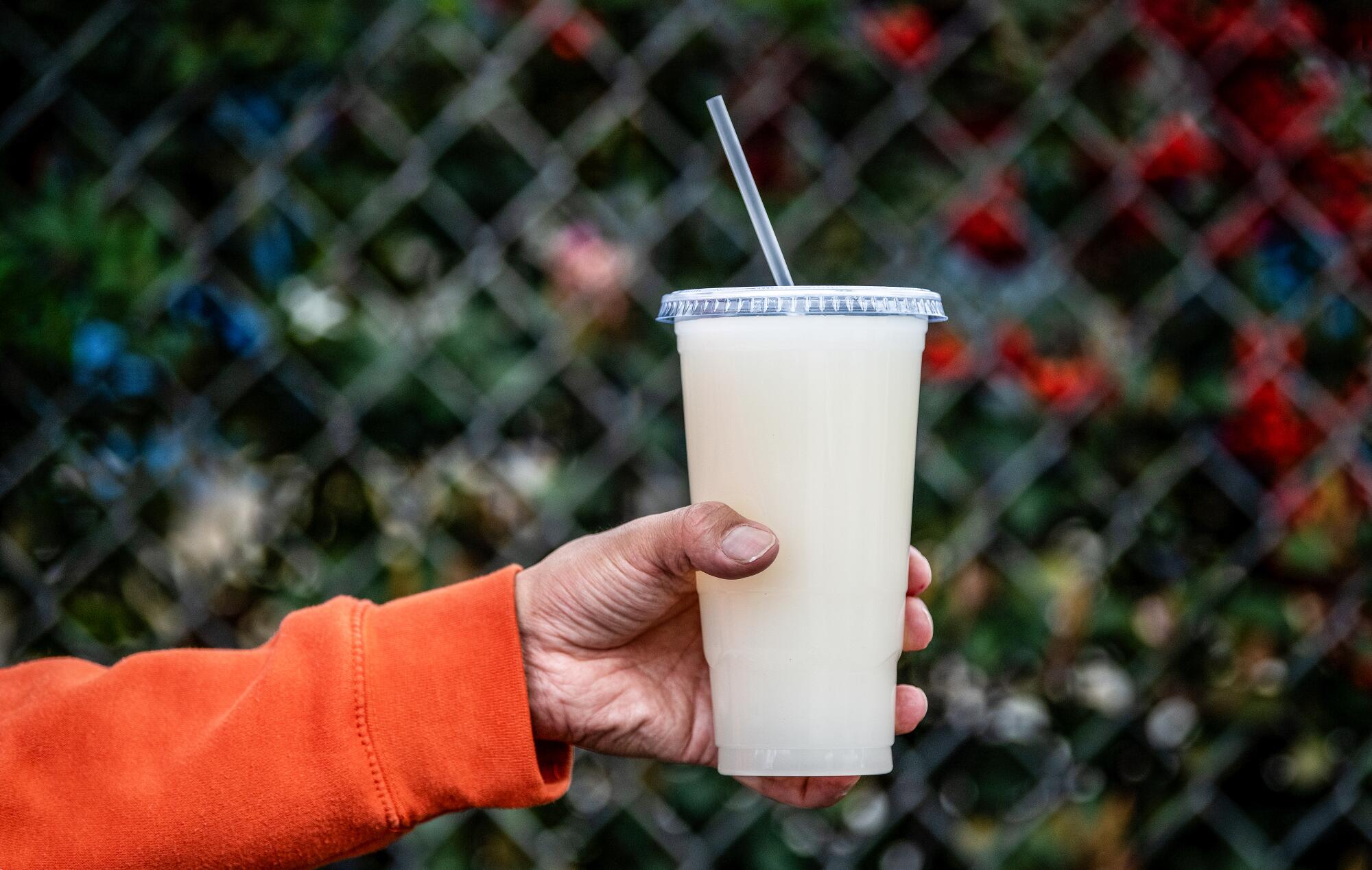
More to Read
Eat your way across L.A.
Get our weekly Tasting Notes newsletter for reviews, news and more.
You may occasionally receive promotional content from the Los Angeles Times.

